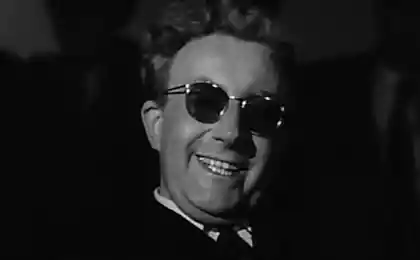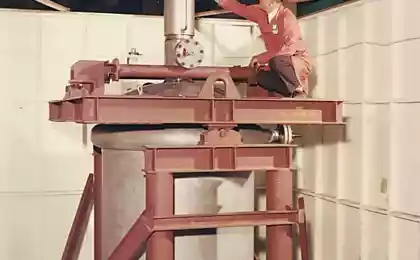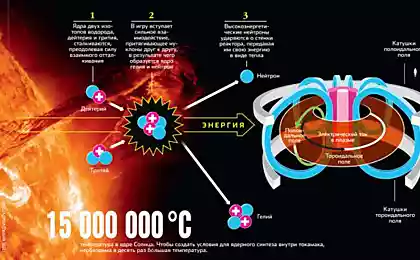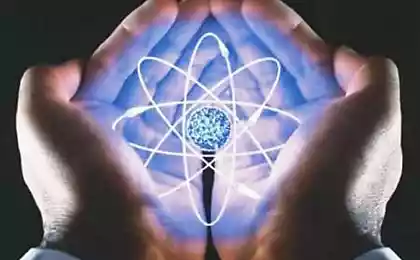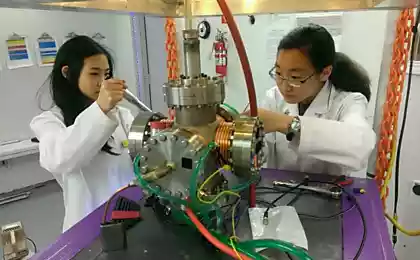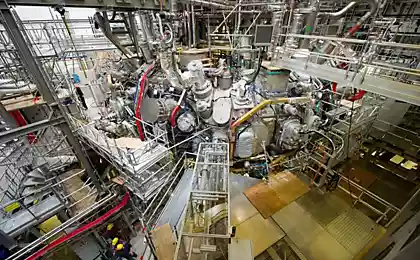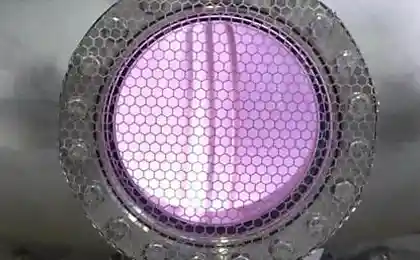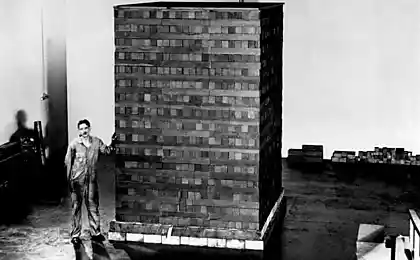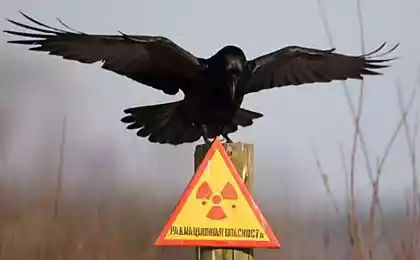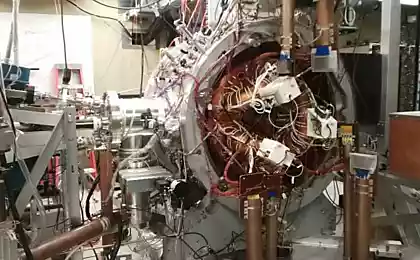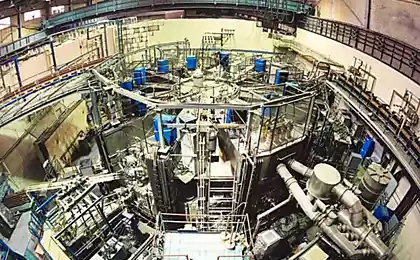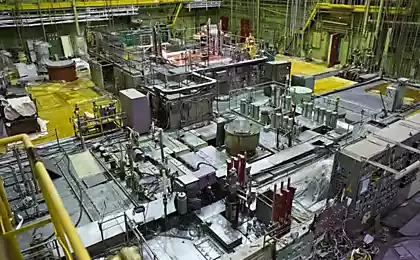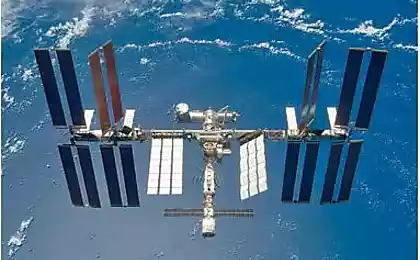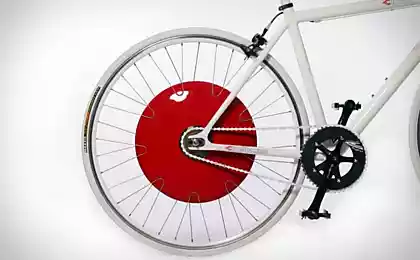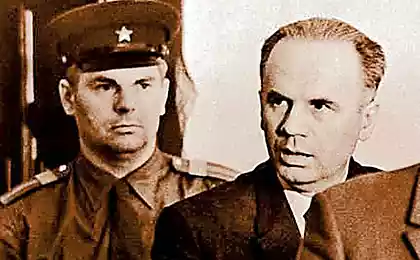1046
Nuclear Materials: IFMIF / EVEDA
Formation of nuclear energy at the time required the creation of a large reservoir of materials. If we take the nuclear reactor, then to the standard problems of strength when heated to any material to add the requirements for a particular interaction with the radiative flux within the reactor. The most important are the properties of interaction with neutrons - and in terms of the entire reactor neutron physics (absorbs whether this structural metal neutrons? Wrinkles? Reflects? Activated?) And in terms of the material itself. What happens in the material under the influence of radiation?
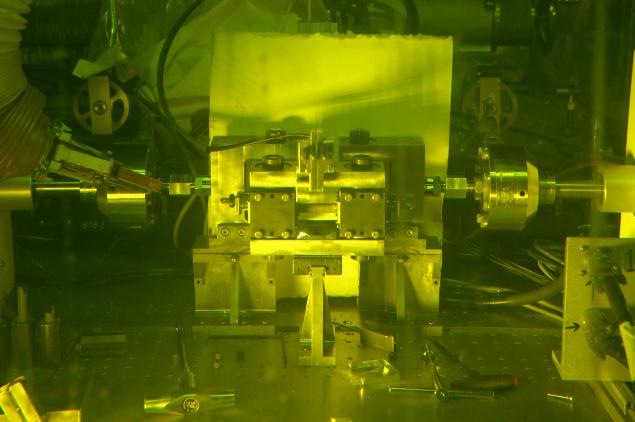
Test Tear irradiated sample in the "hot cell". Laboratory ORLN. I>
Fast particles "break" the bars, causing jumps of atoms of the material on them. This leads to a decrease in ductility and increased brittleness. The neutrons are absorbed by different atoms, causing them transmutation - the transformation into heavier elements (eg Fe56 + and - & gt; Mn57). Most often, the resulting radioactive isotope, and it breaks after some time. Since the activation of the material - the saturation of its radioactive isotopes These radioactive isotopes can decay to form an alpha particle. Alpha particles do not leave the matter, and recombined into helium. The helium accumulates inside the material causes it to swelling and cracking. Similar processes (on a smaller scale) occur with accumulation of hydrogen, which is produced by the decay of neutrons. For a very quick incident neutrons can direct the collapse of the atom structural material to form a plurality of fragments and highly radioactive residue. Activation of material leads to a change in its chemical composition and various corrosion processes. Particularly difficult to account for in the field of welding and junctions
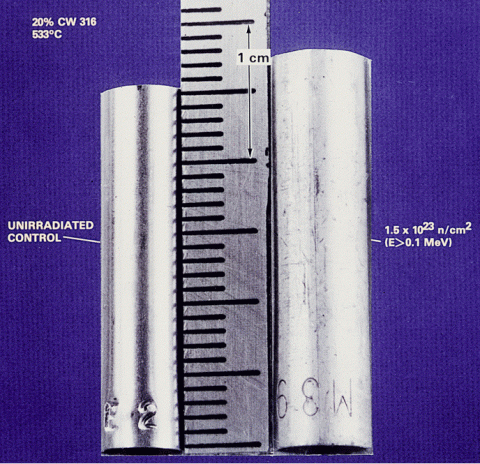
Swelling sample of stainless steel under the influence of neutrons i>
Universal measure of how far they go destructive process is the value of dpa - Displacements per atom (dpa or in English literature). It means the average number of each atom acts have interaction with radiation. Characteristic values for nuclear reactors - from 5 to 60 dpa
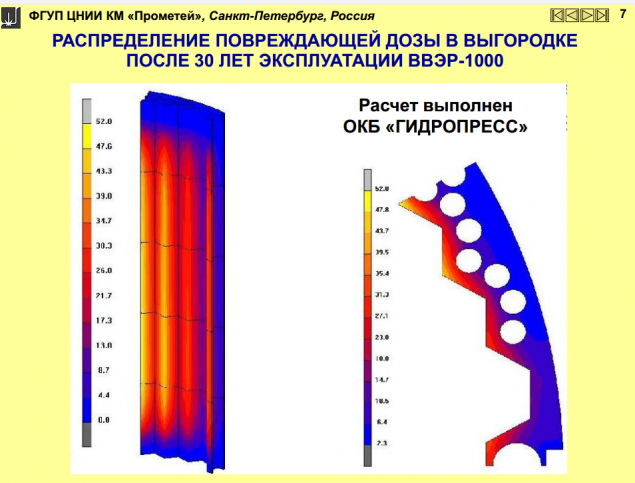
The calculated radiation damage cubicle VVER-1000 s.n.a. I>
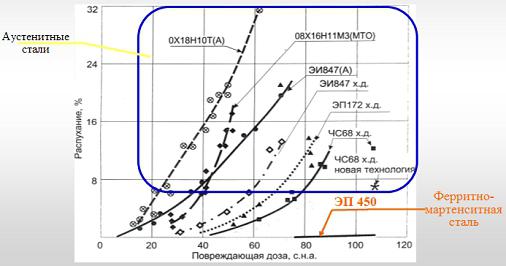
The impact of reactor conditions for various types of steel. EI / ES - special steel reactor. I>
Material scientists have come up with a lot of alloy steels and non-metallic materials for use in such conditions. They, incidentally, frequently distinguished crazy precision composition, it comes to the accuracy of 0, 01% of the content of dopants. Today, 60 dpa It is the limit for the present nuclear materials, such materials also are limited in operating temperature, and can not for example be used in hot fast reactors.

different content of oxygen and iron, zirconium alloys. Please note that the tolerance range of dopants ~ 500 ppm, ie 0, 05% i>
However, for future fast reactors fission and fusion reactors need for materials that can stand up to 150 (preferably 300) dpa without damage, and in the case of fusion - be not only in the neutron flux, but flux superenergetic neutrons. By the way, one of the main problems of this section is a slow set of materials damaging doses - 20 s.n.a year in the best reactors, ie that would dial 160 dpa, it is necessary to leave the assembly in reatore for 8 years.
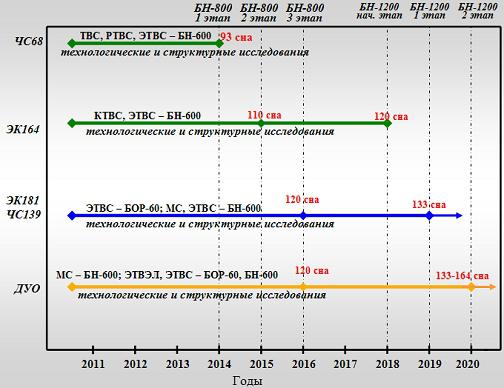
advanced reactor materials and programs irradiation in BOR-60. I>
In order to create and test materials for future fusion reactors need specific sources of thermonuclear neutrons. There will not do any high-flux research nuclear reactors or spalyatsionnye (accelerator) installation. Therefore, in the 2000s, Europe and Japan have adopted a program to create a special research laboratory IFMIF / EVEDA Test of Advanced Materials.
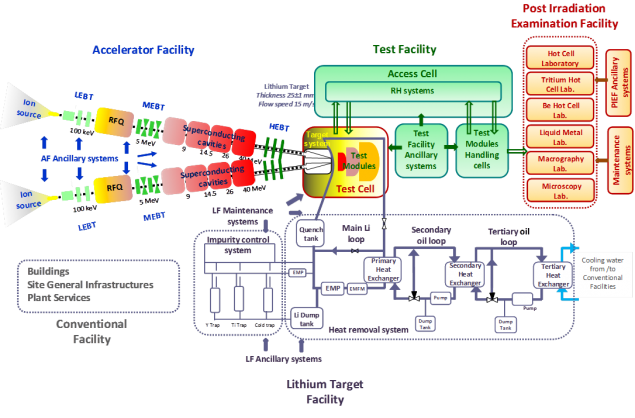
The scheme IFMIF / EVEDA

And the plan of the building. Find a person in this "laboratory». I>
Installing IFMIF is a two small but high-deuteron accelerator (deuterium ions) to an energy of about 40 MeV lithium target (namely pouring stream of liquid lithium, 25 mm thick). Accelerator rather unique high current (125 mA), issued in a constant (not pulsed) mode. The accelerator consists of traditional elements - a plasma ion source, focusing systems (LEBT, MEBT, HEBT), radio frequency accelerator module electrodynamic ion confinement (RFQ) and radio frequency accelerator module retention and electromagnetic resonator cavity (SRF Linac).
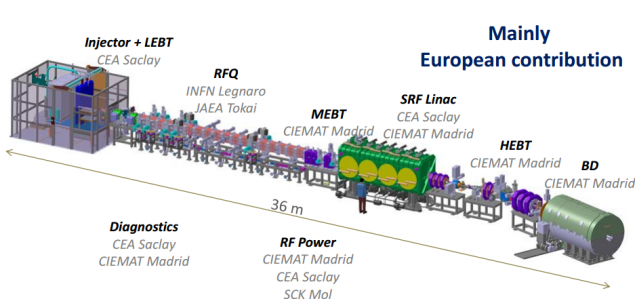
Accelerator IFMIF, its elements and developers. I>
Deuterons accelerated by two identical accelerators react with lithium by reaction D + Li - & gt; 2He + n. This formed the neutron is very similar to the fusion of their energy. Lithium target, by the way, is also quite unique design dedicated to cleaning lithium from the fission products and forming zavesnuyu target.
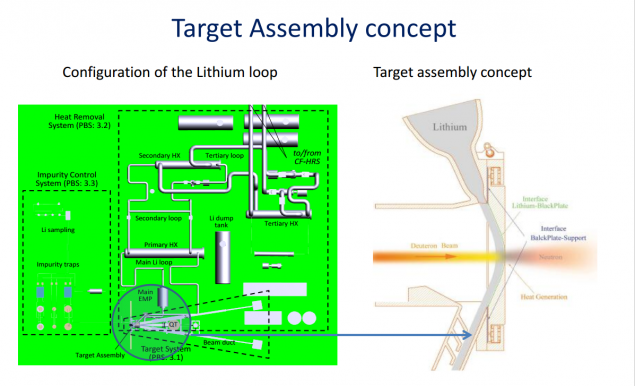
The scheme lithium target ... i>

... and its prototype in full size! I>
The resulting neutrons arrive at the test volume, which has a chamber with different power neutron flux. In the most high-intensity camera (just half a liter in volume that nevertheless allows you to experience a lot of small samples simultaneously) creates a stream of 10 ^ 18 N * sec / cm ^ 2 - is 200 times more than the most high flux nuclear reactors. There are cameras and with less intensity, which, however, already allow testing whole experimental design with coolant etc.
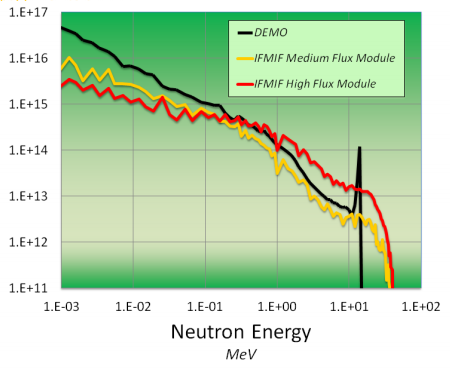
The spectral power of the neutron flux in a promising fusion reactor DEMO, and laboratories IFMIF. I>
The second part of the lab (EVEDA) - is a hot cells for any research that has happened to irradiated samples, how to change their mechanical, physical and chemical properties.
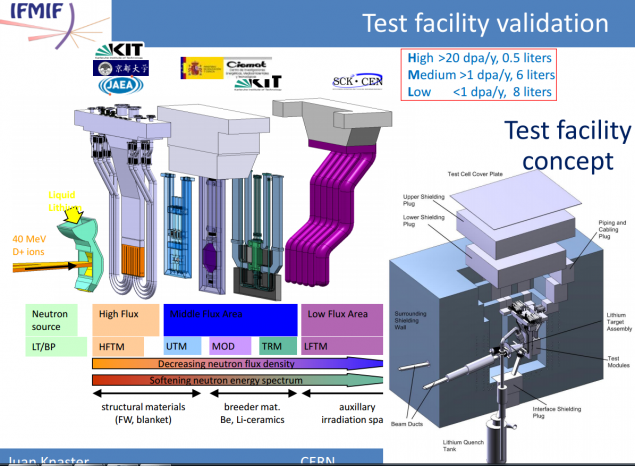
Irradiation chamber IFMIF / EVEDA In the center HFTM speed dial doses of fast neutrons will be 60 years of sleep. I>

Samples of materials that will be tested in IFMIF. Just vysokopotochnyh camera can hold up to 1,000 such samples. I>

And here are some hot cells for research irradiated samples. I>
At the moment, there is a phased installation and start-up equipment (so - "head" of the accelerator, the ion source is already being tested at full operation). Equipment installation is made by both the European and Japanese organizations.
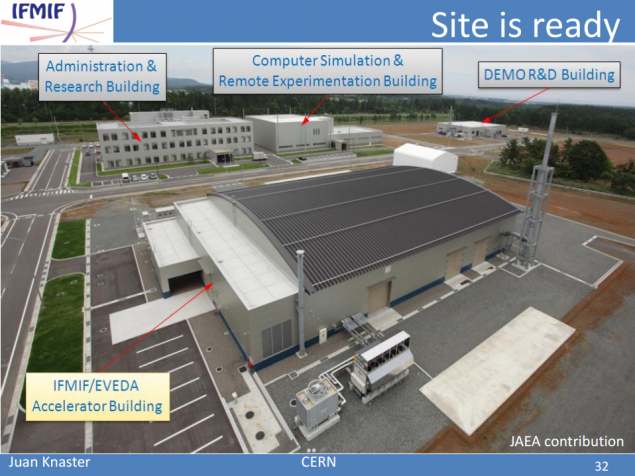
The building, where the IFMIF / EVEDA in Rokkasho, Japan. I>
After starting the lab in 2017 it will begin intensive studies of promising materials for the first wall, blanket and other elements of fusion reactor, "living" in the most severe radiation studies. Perhaps this is where advanced materials such as vanadium-titanium alloys or silicon carbide SiC move from looking in a statement. If these characteristics will be close to the expected, the industrial tokamaks can become much closer, and many of the "paper" concept of nuclear fission reactors (eg travelling wave reactor) will be possible.
Source: geektimes.ru/post/259638/

Test Tear irradiated sample in the "hot cell". Laboratory ORLN. I>
Fast particles "break" the bars, causing jumps of atoms of the material on them. This leads to a decrease in ductility and increased brittleness. The neutrons are absorbed by different atoms, causing them transmutation - the transformation into heavier elements (eg Fe56 + and - & gt; Mn57). Most often, the resulting radioactive isotope, and it breaks after some time. Since the activation of the material - the saturation of its radioactive isotopes These radioactive isotopes can decay to form an alpha particle. Alpha particles do not leave the matter, and recombined into helium. The helium accumulates inside the material causes it to swelling and cracking. Similar processes (on a smaller scale) occur with accumulation of hydrogen, which is produced by the decay of neutrons. For a very quick incident neutrons can direct the collapse of the atom structural material to form a plurality of fragments and highly radioactive residue. Activation of material leads to a change in its chemical composition and various corrosion processes. Particularly difficult to account for in the field of welding and junctions

Swelling sample of stainless steel under the influence of neutrons i>
Universal measure of how far they go destructive process is the value of dpa - Displacements per atom (dpa or in English literature). It means the average number of each atom acts have interaction with radiation. Characteristic values for nuclear reactors - from 5 to 60 dpa

The calculated radiation damage cubicle VVER-1000 s.n.a. I>

The impact of reactor conditions for various types of steel. EI / ES - special steel reactor. I>
Material scientists have come up with a lot of alloy steels and non-metallic materials for use in such conditions. They, incidentally, frequently distinguished crazy precision composition, it comes to the accuracy of 0, 01% of the content of dopants. Today, 60 dpa It is the limit for the present nuclear materials, such materials also are limited in operating temperature, and can not for example be used in hot fast reactors.

different content of oxygen and iron, zirconium alloys. Please note that the tolerance range of dopants ~ 500 ppm, ie 0, 05% i>
However, for future fast reactors fission and fusion reactors need for materials that can stand up to 150 (preferably 300) dpa without damage, and in the case of fusion - be not only in the neutron flux, but flux superenergetic neutrons. By the way, one of the main problems of this section is a slow set of materials damaging doses - 20 s.n.a year in the best reactors, ie that would dial 160 dpa, it is necessary to leave the assembly in reatore for 8 years.

advanced reactor materials and programs irradiation in BOR-60. I>
In order to create and test materials for future fusion reactors need specific sources of thermonuclear neutrons. There will not do any high-flux research nuclear reactors or spalyatsionnye (accelerator) installation. Therefore, in the 2000s, Europe and Japan have adopted a program to create a special research laboratory IFMIF / EVEDA Test of Advanced Materials.

The scheme IFMIF / EVEDA

And the plan of the building. Find a person in this "laboratory». I>
Installing IFMIF is a two small but high-deuteron accelerator (deuterium ions) to an energy of about 40 MeV lithium target (namely pouring stream of liquid lithium, 25 mm thick). Accelerator rather unique high current (125 mA), issued in a constant (not pulsed) mode. The accelerator consists of traditional elements - a plasma ion source, focusing systems (LEBT, MEBT, HEBT), radio frequency accelerator module electrodynamic ion confinement (RFQ) and radio frequency accelerator module retention and electromagnetic resonator cavity (SRF Linac).

Accelerator IFMIF, its elements and developers. I>
Deuterons accelerated by two identical accelerators react with lithium by reaction D + Li - & gt; 2He + n. This formed the neutron is very similar to the fusion of their energy. Lithium target, by the way, is also quite unique design dedicated to cleaning lithium from the fission products and forming zavesnuyu target.

The scheme lithium target ... i>

... and its prototype in full size! I>
The resulting neutrons arrive at the test volume, which has a chamber with different power neutron flux. In the most high-intensity camera (just half a liter in volume that nevertheless allows you to experience a lot of small samples simultaneously) creates a stream of 10 ^ 18 N * sec / cm ^ 2 - is 200 times more than the most high flux nuclear reactors. There are cameras and with less intensity, which, however, already allow testing whole experimental design with coolant etc.

The spectral power of the neutron flux in a promising fusion reactor DEMO, and laboratories IFMIF. I>
The second part of the lab (EVEDA) - is a hot cells for any research that has happened to irradiated samples, how to change their mechanical, physical and chemical properties.

Irradiation chamber IFMIF / EVEDA In the center HFTM speed dial doses of fast neutrons will be 60 years of sleep. I>

Samples of materials that will be tested in IFMIF. Just vysokopotochnyh camera can hold up to 1,000 such samples. I>

And here are some hot cells for research irradiated samples. I>
At the moment, there is a phased installation and start-up equipment (so - "head" of the accelerator, the ion source is already being tested at full operation). Equipment installation is made by both the European and Japanese organizations.

The building, where the IFMIF / EVEDA in Rokkasho, Japan. I>
After starting the lab in 2017 it will begin intensive studies of promising materials for the first wall, blanket and other elements of fusion reactor, "living" in the most severe radiation studies. Perhaps this is where advanced materials such as vanadium-titanium alloys or silicon carbide SiC move from looking in a statement. If these characteristics will be close to the expected, the industrial tokamaks can become much closer, and many of the "paper" concept of nuclear fission reactors (eg travelling wave reactor) will be possible.
Source: geektimes.ru/post/259638/
Cat's blockbuster
Preparation for surgery using 3D-printed models of Boston's Children's Hospital helps save lives
